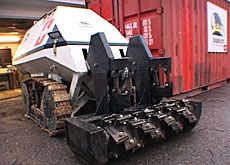
Swiss device targets deadly mines

A Swiss engineer has developed a machine that promises to speed up the process of clearing mines and vastly reduce casualties among de-mining staff.
Digger-1 is designed to eliminate the danger posed by directional fragmentation mines, which are responsible for 80 per cent of mine clearance accidents in the Balkans.
These deadly weapons, which are triggered by trip wires, use a shaped charge that fires hundreds of lethal metal fragments in a certain direction.
The four-ton, remote-controlled Digger-1, which is a cross between a tank and a lawnmower, can eliminate the danger while its operator remains out of harm’s way.
Developed by Frédéric Guerne, an electrical engineer from Courtelary in canton Bern, the diesel-powered vehicle has a range of 300 metres and uses a cutting arm to hack down small bushes and grass.
If the vehicle triggers a fragmentation mine, its armoured body enables it to withstand the blast.
The inexpensive wooden caterpillar tracks are the only casualty, but can quickly be replaced.
Safety first
And whereas it takes de-miners all day to clear just 50 metres square of terrain, Digger-1 cleans up more quickly over a wider area.
“They [de-miners] spend half of their time clearing away grass and bushes, using scissors and saws, so they can find and disarm fragmentation mines, before scouring fields for anti-personnel mines,” explains Guerne.
“Digger-1 can speed up the work by 50 per cent and make the fields much safer for the de-mining staff.”
The sooner minefields can be cleared, the quicker local populations can resume farming activity in the area.
During development of the chassis and tracks, Digger-1 was tested many times on Swiss terrain. The Swiss army provided secure areas where the vehicle could be subjected to explosions.
Active duty
Digger-1 was sent on a six-week test drive near the Kosovo/Albanian border, where an unknown number of mines and booby traps were planted during the 1999 war by retreating Serb forces.
Digger-1 was driven over three anti-tank mines, without being seriously damaged itself.
The vehicle was operated by members of a Geneva-based non-governmental organisation, the Swiss Association for Mine Clearing.
Transport and accommodation for the seven-man test team was provided free of charge by the Swiss army. The team was pleased with the machine’s performance and concluded that the prototype will need very little adaptation.
Guerne now wants to build a lighter, three-ton model, with improved ventilation – the mine-detector overheated in Albania.
He says it is also difficult to steer the vehicle at a distance of more than 50 metres, as the operator cannot see what the machine is doing from that far away. The answer might be to add a camera with zoom capabilities.
Hard work
It took Guerne and thirty volunteers three years to build the prototype, working in a borrowed barn at the foot of the Jura mountains.
Friends and fellow engineers donated most of the equipment and tools used to make the prototype, as well as contributing ideas and expertise.
They have already invested 15,000 hours and SFr150,000 ($103,750) in the Digger DTR (De-mining Technologies Research) project.
Most nights, Guerne can be found in this small “workshop”, fine-tuning Digger-1, and poring over plans and drawings. “I never go to bed before eleven,” he told swissinfo.
He is now seeking funding from various sources, including the Swiss government, to enable him to continue with the project.
swissinfo, Julie Hunt
The 1997 Mine Ban Treaty has been signed by 130 states.
Forty-eight nations remain outside its remit, including the US, Russia, China, India, Pakistan, Israel and Egypt.
Up to 20,000 people are killed or maimed by mines and unexploded ordinance every year.
The Swiss-made Digger-1 promises to speed up mine-clearing work by 50 per cent and reduce casualties among de-mining staff by up to 80 per cent.
Frédéric Guerne, an electrical engineer from Courtelary in canton Bern, has spent three years developing a machine to help save the lives of de-mining personnel and enable them to work more efficiently.
The prototype Digger-1 has been tested in minefields in the Balkans and found to be highly effective.
But further development of Digger-1 is being hampered by a lack of funding.

In compliance with the JTI standards
More: SWI swissinfo.ch certified by the Journalism Trust Initiative































You can find an overview of ongoing debates with our journalists here . Please join us!
If you want to start a conversation about a topic raised in this article or want to report factual errors, email us at english@swissinfo.ch.